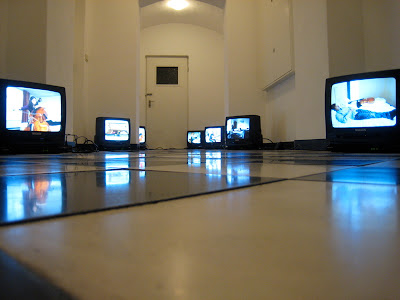
One of my favourite hobbies is spying on people. Not in a creepy restraining-order kind of way but in a harmless curious-about-how-other-people-live kind of way.
I like to walk along residential streets at night and look into people's windows. I don't jump the fence and press my face up against the glass (the last time I tried that I tripped and fell into a bed of stinging nettles). I just see what I can see from the street as I walk past. If the lights are on and the curtains are open, well, that's pretty much an invitation to peek inside.
I'm not looking to catch anyone in a compromising position. I'm more interested in the mundane details. The colour of the walls, the way the furniture is arranged, what's on TV, what's on the walls, the harshness or the softness of the lighting. This is the stuff that fascinates me. A room is a living canvas that we fill with things that reflect our personalities and preferences. We create nests that are pleasing to us because they are an extension of us.
My strong attachment to my own home probably explains why I'm so obsessed with seeing how other people live. I look inside their windows and ask myself a million little questions. Who are they? What do they do for a living? Are they happy? And what kind of person would hang a German flag on the wall and put a collection of empty whiskey bottles on top of a bookshelf and call it decorating?
When I see a really beautiful apartment -- one with high ceilings, big windows, and minimal, but tasteful, furniture -- I fantasize about what it would be like to live there. I imagine myself walking up the steps, pushing open the door, stepping into the living room and sinking into the down-filled couch. It's not late-night lurking. It's window shopping for an alternate reality.
Bonn is a voyeur's paradise. The houses butt right up against the sidewalk and the curtains on the floor-to-ceiling windows are rarely closed. My neighbourhood is full of elegant old houses and as much as I enjoy the occasional peek into the front room through parted curtains, it always leaves me wanting more.
So when my landlady Christine told me some local artists were opening up their homes to the public on the weekend, I was more excited about seeing the inside of their apartments than I was about seeing their art. Christine (pictured below) was the only participating artist whose work captured my full attention since I see the inside of her house on a daily basis.

The Offfene Ateliers in der Sudstadt has become something of a Bonn tradition. Once a year, a group of artists open their studios (which are usually located inside their apartments) to the public. The only way to find their homes is to follow a specially made map pinpointing their location. You walk up to the artist's apartment, ring the buzzer and are quietly let in. The event is open to the public but it feels secretive. Without the map, you wouldn't know where to go.
My friend Emily was my date for the afternoon. Together, we walked along the wealthy residential streets of Sudstadt, going from one apartment to the next. It felt a little bit like trick-or-treating but without the costumes or the candy (although I did notice a bowl filled with mini Snickers at one of the apartments we visited).
There were 18 participating artists and in a five-hour period we only managed to visit eight of them. The artists walked around their homes answering questions or chatting up potential buyers. I walked around the rooms drinking in the mundane details.
I checked out the colour of the walls (I was especially fond of the kitchen painted pink and the living room painted orange), I looked at the furniture (most of it was well-made, sturdy and practical), I glanced at the books on bookshelves (the titles were almost always in German), and paid attention to what was hanging on the walls (lots and lots of art).





I liked the event, I liked the art and I liked poking around people's homes. Especially because these were the very same homes I had walked past dozens of times before. These were the same windows I had peeked in and the same occupants I had wondered about.
I now know that inside one of these houses lives a guy who has never been to Canada and inside another lives a handsome architect with ashtrays in every room and a cat sleeping upstairs. I still walk past these houses at night but now I see a little bit more.








